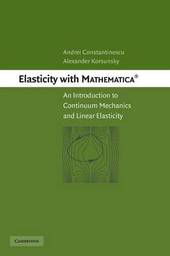
|
Elasticity with Mathematica (R): An Introduction to Continuum Mechanics and Linear Elasticity
Hardback
Main Details
| Title |
Elasticity with Mathematica (R): An Introduction to Continuum Mechanics and Linear Elasticity
|
| Authors and Contributors |
By (author) Andrei Constantinescu
|
|
By (author) Alexander Korsunsky
|
| Physical Properties |
| Format:Hardback | | Pages:266 | | Dimensions(mm): Height 254,Width 178 |
|
| Category/Genre | Mechanical engineering |
|---|
| ISBN/Barcode |
9780521842013
|
| Classifications | Dewey:620.1/1232015118 620.11232015118 |
|---|
| Audience | | Professional & Vocational | |
|---|
|
Publishing Details |
| Publisher |
Cambridge University Press
|
| Imprint |
Cambridge University Press
|
| Publication Date |
8 October 2007 |
| Publication Country |
United Kingdom
|
Description
This book introduces key ideas and principles in the theory of elasticity with the help of symbolic computation. Differential and integral operators on vector and tensor fields of displacements, strains and stresses are considered on a consistent and rigorous basis with respect to curvilinear orthogonal coordinate systems. As a consequence, vector and tensor objects can be manipulated readily, and fundamental concepts can be illustrated and problems solved with ease. The method is illustrated using a variety of plane and three-dimensional elastic problems. General theorems, fundamental solutions, displacements and stress potentials are presented and discussed. The Rayleigh-Ritz method for obtaining approximate solutions is introduced for elastostatic and spectral analysis problems. Containing more than 60 exercises and solutions in the form of Mathematica notebooks that accompany every chapter, the reader can learn and master the techniques while applying them to a large range of practical and fundamental problems.
Author Biography
Andrei Constantinescu is currently the directeur de Recherches at CNRS: The French National Center for Scientific Research in the Laboratoire de Mecanique des Solide, and Associated Professor at Ecole Polytechniuqe, Paris. He teaches courses on continuum mechanics, elasticity, fatigue, and inverse problems at engineering schools in the Paris area. His research is in applied mechanics and covers areas ranging from inverse problems and the identification of defects and constitutive laws to fatigue and lifetime prediction of structures under cyclic loading conditions. His research has been applied through collaboration and consulting for companies such as the car manufacturer Peugeot-Citroen, energy providers Electricite de France and Gaz de France, and the aeroengine manufacturer MTU. Alexander Korsunsky is currently a professor in the Department of Engineering Science, University of Oxford. He is a Fellow and Dean at Trinity College, Oxford. He teaches courses in England and France on engineering alloys, fracture mechanics, applied elasticity, advanced stress analysis, and residual stresses. His research interests are in the field of experimental characterization and theoretical analysis of deformation and fracture of metals, polymers, and concrete, with emphasis on thermo-mechanical fatigue and damage. He is particularly interested in residual stress effects and their measurement by advanced diffraction techniques using neutrons and high-energy X-rays at Synchrotron sources and in the laboratory. He is a member of the Science Advisory Committee of the European Synchrotron Radiation Facility in Grenoble, and he leads the development of the new engineering instrument (JEEP) at Diamond Light Source near Oxford.
Reviews"Constantinescu (engineering, French National Center for Scientific Research and <'E>cole Polytechnique, Palaisea) and Korsunsky (engineering science, U. of Oxford) use plane and three-dimensional problems, general theorems, fundamental solutions, displacements and stress potentials to introduce key ideas and principles in the theory of elasticity. They keep the narrative relatively simple, provide study aids such as outlines and summaries and offer exercises students can work using "notebooks" from the popular software product. The result is a significant advance in the study of elasticity, with topics such as kinematics (in terms of displacement and strains), dynamics and stress (in terms of stresses and equilibrium, with full due to Cauchy), linear elasticity, general principles (including that of Saint Venant), stress functions (including the work of Kelvin, Williams, Kirsch and Inglis), displacement potentials (including Papkovich-Neuber potentials and the Galerkin vector), energy principles and variational formulations. They include a nice appendix on helpful software tricks." Book News Inc
|